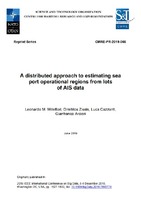| dc.contributor.author | Millefiori, Leonardo | |
| dc.contributor.author | Zissis, Dimitrios | |
| dc.contributor.author | Cazzanti, Luca | |
| dc.contributor.author | Arcieri, Gianfranco | |
| dc.date.accessioned | 2019-06-19T10:02:49Z | |
| dc.date.available | 2019-06-19T10:02:49Z | |
| dc.date.issued | 2019/06 | |
| dc.identifier.govdoc | CMRE-PR-2019-066 | en_US |
| dc.identifier.uri | http://hdl.handle.net/20.500.12489/806 | |
| dc.description.abstract | Seaports play a vital role in the global economy, as they operate as the connection corridors to all other modes of transport and as engines of growth for the wider region. But ports today are faced with numerous unique challenges and for them to remain competitive, significant investments are required. In support of greater transparency in policy making, decisions regarding investment need to be supported by data-driven intelligence. It is often an overlooked fact that seaports do not remain static over time; such spatial units often evolve according to environmental patterns both in size but also connectivity and operational capacity. As such any valid decision making regarding port investment and policy making, essentially needs to take into account port evolution over time and space. In this work, we leverage the huge amounts of vessel data that are progressively becoming available through the Automatic Identification System (AIS) and distributed machine learning to define a seaport's extended area of operation. Specifically, we present our adaptation of the well-known KDE algorithm to the map-reduce paradigm, and report results on the port of Shanghai. | en_US |
| dc.format | 6 p. : ill. ; digital, PDF file | en_US |
| dc.language.iso | en | en_US |
| dc.publisher | CMRE | en_US |
| dc.source | In: 2016 IEEE International Conference on Big Data, 5-8 December 2016, Washington DC, USA, pp. 1627-1632, doi: 10.1109/BigData.2016.7840774 | en_US |
| dc.subject | Maritime situational awareness | en_US |
| dc.subject | Maritime security | en_US |
| dc.subject | Information fusion | en_US |
| dc.subject | Artificial intelligence | en_US |
| dc.subject | Big data | en_US |
| dc.subject | Maritime route extraction | en_US |
| dc.subject | Ship movements | en_US |
| dc.subject | Shanghai | en_US |
| dc.subject | Ports | en_US |
| dc.title | A distributed approach to estimating sea port operational regions from lots of AIS data | en_US |
| dc.type | Reprint (PR) | en_US |
| dc.type | Papers and Articles | en_US |
